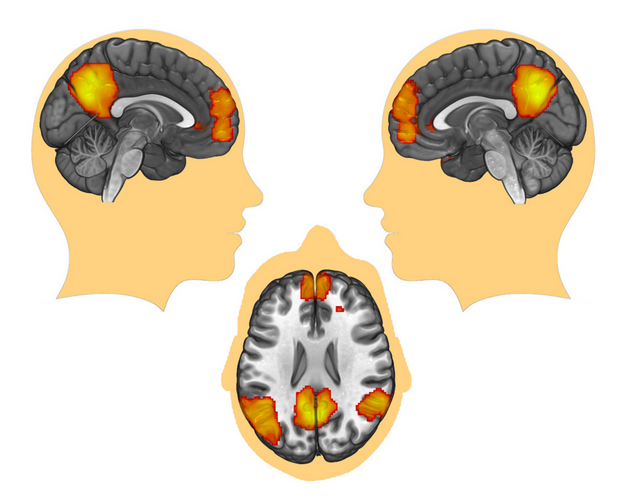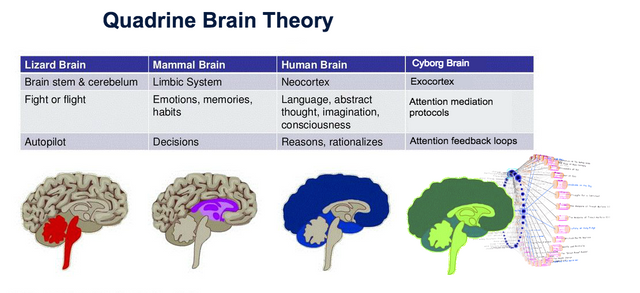Default mode network as an adaptation for pack-hunting, eusocialization a second order adaptation, and how the exocortex makes default modes obsolete
If the human brain evolved to run trance-states, social roles, first via an expansion of pre-frontal cortex for trance-states based on dominance hierarchies, to pack hunt, an adaptation that canids also developed, and then via further neoteny into co-opting hierarchies for religion, submission to a legal system which no one controlled, a distributed system built on eusociality.
Edward O Wilson in his 2012 book The Social Conquest of Earth described humans as "a eusocial species of ape", living for society. Insects are often eusocial. Emile Durkheim talked about Homo duplex, saying that a man on the one hand is a biological organism, driven by instincts, with desire and appetite and on the other hand is being led by morality and other elements generated by society.
Two phases of neoteny: bipedal hairless pack-hunters, then submissive eusocial Homo duplex
Child chimpanzees look a lot like humans. Possibly, the hairlessness and bipedalism could have evolved by neoteny, and alleles and genes may have been silenced and so on, similar to how ducks still have genes for teeth, albeit silent, and how Jack Horner has re-activated those in his "chickenosaurus".
Bipedalism led to pack-hunting, and a rich food supply of meat. Predatory adaptations, dominance hierarchies adapted for hunting, addiction to meat. This led to brain growth, perhaps by more neoteny as genes that silenced brains to stop growing were silenced.
Fire, advanced tools, agriculture, co-incided with difficult child birth because the head of the child grew too big. While pack-hunting, males and females both participated in hunting, similar to wolves, with decreased sexual dimorphism.
If the persistence hunt theory of human evolution is true, then Homo canis could be a name that defines pack-hunting as a characteristic.
Difficult child birth evolved together with eusociality, to form societies and to organize around shared belief in an almost leader-less way. The eusocial human is perhaps better known by Emile Durkheims' Homo duplex, rather than Homo sapien, since it is not tool use or cognition but the eusociality which is characteristic for that phase of the evolution of Homo.
Homo duplex as an animal that organizes by law, extending social functions
Eusocial Homo duplex is perhaps best characterized by that law, via distributed legal systems such as religions, systems that no one controls, acts as extensions of social functions. So rather than extending bodily functions being the defining characteristic, or extending cognitive functions, it is the extension of social functions into complex, insect-like societies, co-opting rich inner worlds for technological evolution.
From Homo duplex to Homo nexus
With the web 3.0, law will go from being based on consensus trances, to be based on math, game theory, economic protocols, and similar things. This networked society will outgrow the use of hierarchical organization, what could be a remnant from the pack-hunting phase and have been less dominant since the adaptations for religion.
With the exocortex, law will be literal extensions of social functions in the human brain, and so easily distinguished as cybernetic extensions, whereas that has been less apparent perhaps in earlier social organization.
With homo nexus, does the default mode network become obsolete?
If the default mode, social cognition and hierarchical self-reflection, the emergence of "self" relative others in a pack, roles, evolved for Homo canis to stay in "consensus" with other members in the pack, and was later co-opted for eusocial belief systems, then what happens as the internet, social media, math-based law on the web 3.0, AI, creates a world where everyone is connected as everyone else?
The Flow Genome Project makes the case that we are evolving towards favoring altered states over default modes. When consensus is automated, with Ethereum being an early form of virtual state, then default modes may loose their evolutionary purpose.
Synapses
On the relationship between the "default mode network" and the "social brain".
Paleontologist Jack Horner is hard at work trying to turn a chicken into a dinosaur
The Evolution of Difficult Childbirth and Helpless Hominin Infants
The Next Billion Seconds
What happens after we're all connected?
Notes
Canids separated from mammals around 40 million years ago, a shift in canid encephalization and architectural re-organisation of the brain, expansion of the procean gyrus at the anterior end of the neocortex, general increase of the amount of infolding of the frontal lobe, and expansion of the pre-frontal cortex.-The Social Dog: Behavior and Cognition
"The theory that religions are evolved rather than divinely inspired (or, rather, that divine inspiration is the intersubjective expression of the objective fact of religious evolution), poses an even more ubiquitous attack to those who argue ad absurdum from the intersubjective to the objective or vice versa. If the human mind is incapable of making this distinction, with at least the fluidity that we reason ad absurdum, then our evolved intersubjective truths and values are degraded by the discoveries of objective science (example: atheist Communism), and the attempts to defend valuable intersubjective truths degrade our understanding of objective truths (example: Creationism). "-Objective Versus Intersubjective Truth, Nick Szabo, 1998


